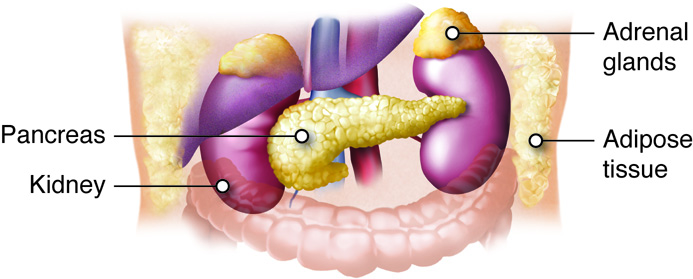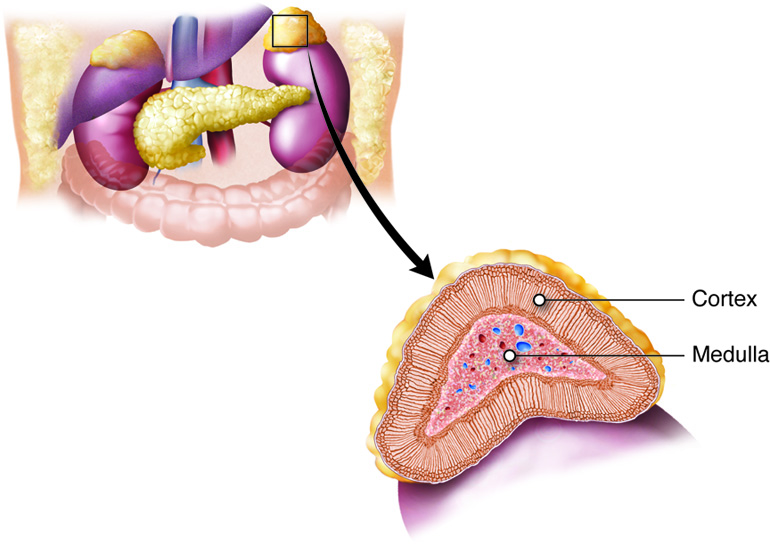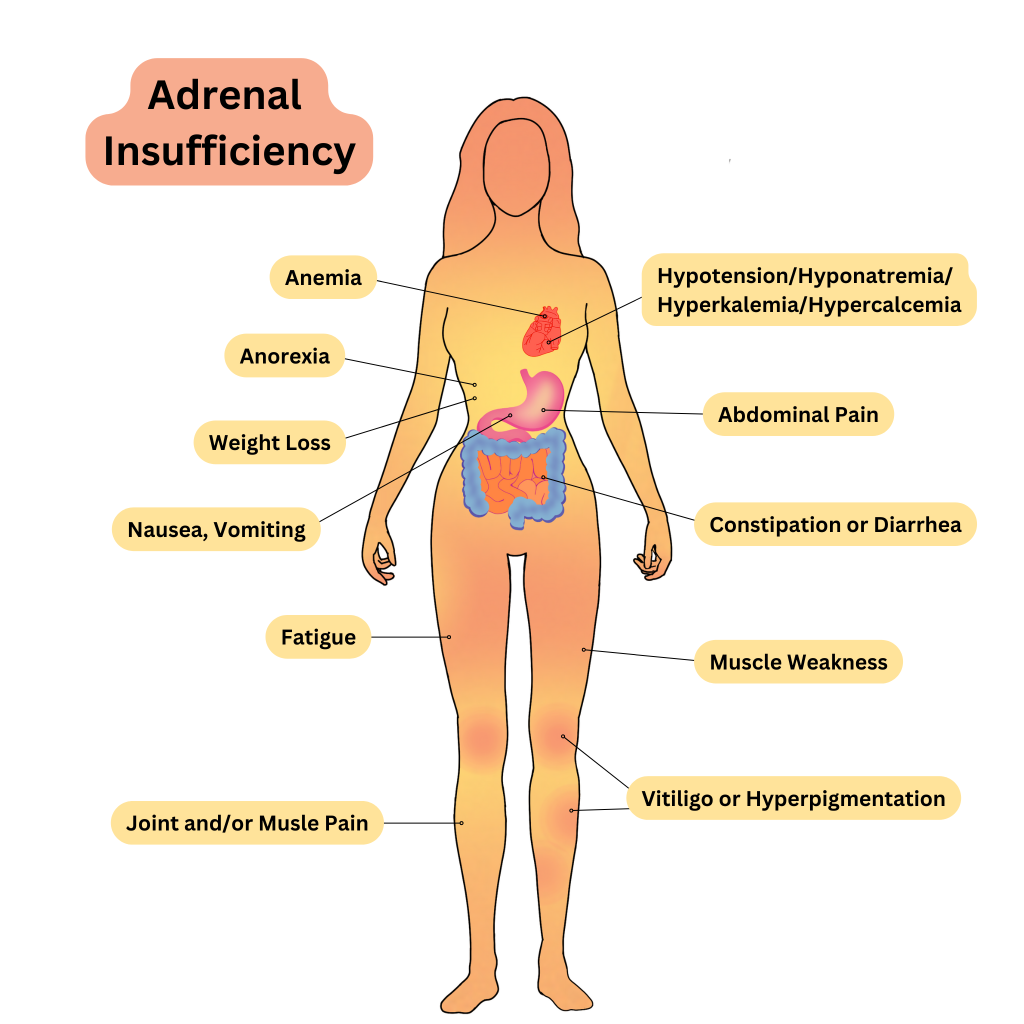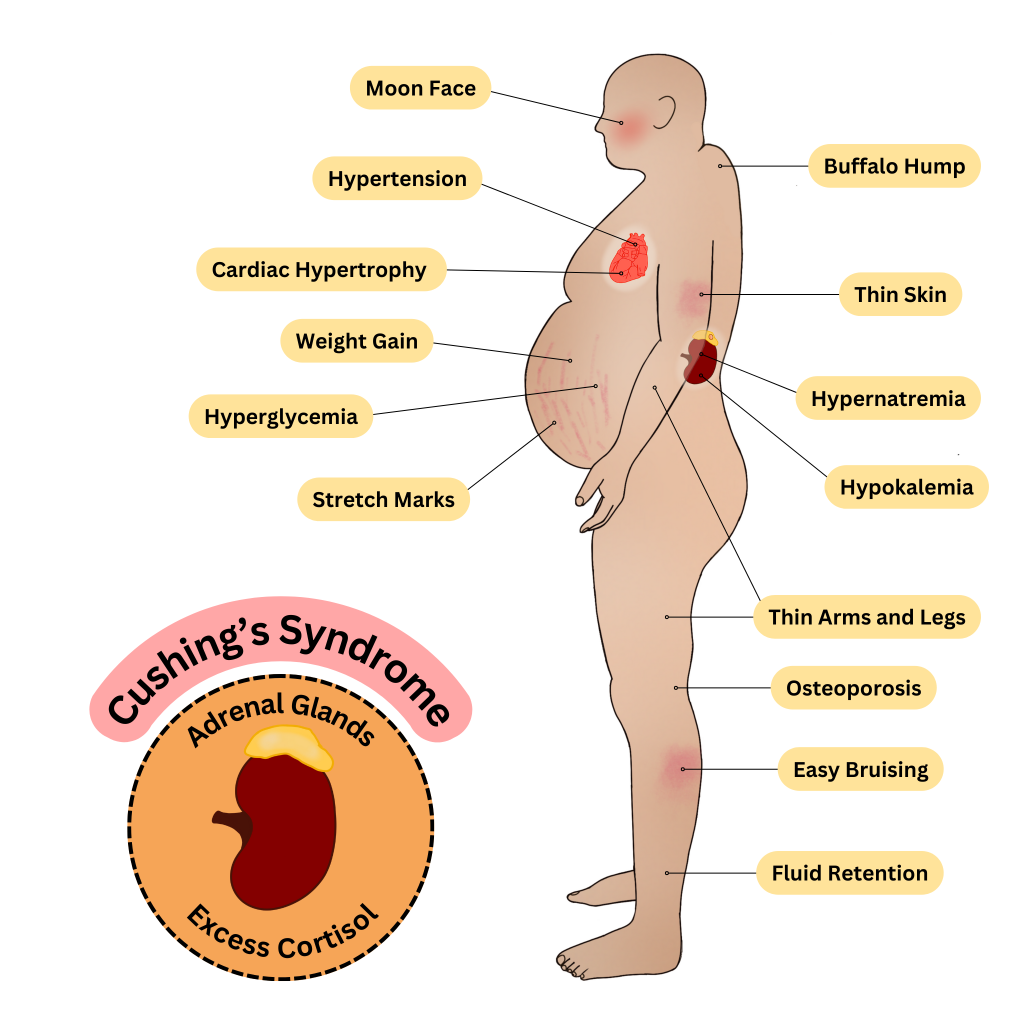7.7 Adrenal Disorders
The adrenal glands are a pair of small, triangular-shaped glands located on top of each kidney. See Figure 7.18[1] for an illustration of the location of the adrenal glands.

The adrenal glands are responsible for producing several hormones that are essential for maintaining overall health and regulating various body functions. The two primary parts of the adrenal glands are the adrenal cortex and the adrenal medulla, each of which produces different hormones. See Figure 7.19[2] for an illustration of adrenal cortex and adrenal medulla.

The adrenal cortex produces corticosteroids, including cortisol and aldosterone, which help to regulate metabolism, immune response, and salt and water balance. Cortisol is a glucocorticoid hormone produced by the adrenal glands that regulates physiological processes in the body. It is referred to as the “stress hormone” due to its involvement in the body’s stress response. Aldosterone is a mineralocorticoid hormone produced by the adrenal gland that regulates the salt and water balance of the body in the kidneys by increasing the retention of sodium and water and excreting potassium.
The adrenal medulla produces catecholamines, including epinephrine and norepinephrine. These hormones help induce the fight-or-flight response and play a critical role in elevating heart rate and blood pressure to prepare the body in times of stress or danger.[3]
Adrenal Insufficiency: Addison’s Disease
Addison’s disease refers to a specific type of adrenal gland insufficiency, resulting in inadequate production of cortisol and aldosterone. Addison’s disease is often the result of an autoimmune response and destruction of the adrenal glands. It can also occur as the result of tuberculosis; infection; or the sudden cessation of long-term, high-dose glucocorticoid treatment.[4]
Addisonian crisis is a life-threatening medical emergency that occurs when the body’s need for the hormones cortisol and aldosterone exceeds the available supply. This crisis is a severe complication of Addison’s disease, a condition in which the adrenal glands do not produce enough of these critical hormones. The crisis often occurs in response to a stressful event, such as an infection, surgery, trauma, or a significant physical or emotional stressor.[5],[6] Read additional information about Addisonian crisis in the following box.
A Closer Look: Emergency Care of Client in Addisonian Crisis[7]
An Addisonian crisis is a life-threatening situation, and prompt medical attention is crucial. In an Addisonian crisis there is a rapid shift in electrolytes. Sodium (Na) levels fall, leading to hyponatremia, while potassium (K) levels rise, causing hyperkalemia. These electrolyte imbalances can result in various life-threatening complications, including cardiac arrhythmias. Low blood pressure is another hallmark sign of an Addisonian crisis. It occurs due to the loss of aldosterone, which subsequently impairs the body’s ability to retain sodium.
Prompt intervention requires administration of intravenous fluids with saline to rapidly correct the dehydration, raise blood pressure, and correct electrolyte imbalances. These fluids help raise blood pressure and restore blood volume. Intravenous corticosteroids, such as hydrocortisone, are administered to rapidly replace the deficient cortisol. If hyperkalemia is present, medications may be given to lower potassium levels and reduce the risk of life-threatening cardiac arrhythmias.
Assessment of Adrenal Insufficiency
Common assessment findings for adrenal insufficiency can be seen in Table 7.7a.
Table 7.7a. Common Manifestations of Adrenal Insufficiency[8]
| Body System | Clinical Manifestations |
|---|---|
| General | Fatigue, weakness, weight loss, and salt cravings |
| Cardiovascular | Hypotension, dizziness, and fainting episodes |
| Gastrointestinal | Abdominal pain, diarrhea, nausea and vomiting, and anorexia (loss of appetite) |
| Musculoskeletal | Muscle weakness, joint pain and stiffness, and muscle and joint aches |
| Endocrine | Hypoglycemia, loss of pubic and axillary hair, amenorrhea (absence of menstrual periods in women), reduced libido and sexual dysfunction, infertility, and oligomenorrhea (infrequent or irregular menstrual periods) |
| Dermatological | Hyperpigmentation (darkening of the skin, especially in sun-exposed areas), skin thinning, easy bruising, vitiligo (loss of skin pigmentation), hyperhidrosis (excessive sweating), and slow wound healing |
| Neurological | Lethargy and apathy, depression and mood changes, difficulty concentrating, confusion and cognitive changes, headache, and irritability |
See Figure 7.20 [9]for an illustration of the clinical manifestations of adrenal insufficiency.

Diagnostic Testing
Diagnosing Addison’s disease involves a combination of clinical assessment, laboratory tests, and specialized tests to confirm adrenal insufficiency. Addison’s disease is characterized by the insufficient production of cortisol and often aldosterone by the adrenal glands, so serum cortisol and aldosterone levels are abnormally low. Additionally, as a result of abnormally low aldosterone levels, electrolyte imbalances can also be found, including hyponatremia (low sodium) and hyperkalemia (elevated potassium).[10] Review normal reference ranges for common diagnostic tests in “Appendix A – Normal Reference Ranges.”
Nursing Diagnoses
Nursing diagnoses for clients with adrenal gland hypofunction can help guide nursing care and address the specific needs of these individuals.
Common nursing diagnoses include the following:
- Risk for Imbalanced Fluid Volume
- Impaired Skin Integrity
- Fatigue
- Imbalanced Nutrition: Less Than Body Requirements
Outcome Identification
Outcome identification includes setting short- and long-term goals and creating expected outcome statements customized for the client’s specific needs. Expected outcomes are statements of measurable action for the client within a specific time frame that are responsive to nursing interventions.
- The client will maintain adequate fluid balance as evidenced by stable vital signs and absence of signs and symptoms of dehydration or fluid overload.
- The client will exhibit intact skin without any signs of breakdown, ulceration, or infection.
- The client will demonstrate improved ability to perform activities of daily living without excessive fatigue.
- The client will achieve and maintain a stable and appropriate body weight.
Interventions for Adrenal Insufficiency
Medical Interventions
Medical interventions for adrenal insufficiency focus on medication therapy to replace the deficient hormones and effectively manage the condition to prevent adrenal crisis.
Medication Therapy
Clients with Addison’s disease are typically prescribed oral glucocorticoid medications, such as hydrocortisone, prednisone, or dexamethasone, to replace deficient cortisol levels. The dose is often divided into multiple daily doses to mimic the body’s natural cortisol release pattern.
Clients may also require mineralocorticoid replacement with medications like fludrocortisone to replace aldosterone and regulate salt and water balances in the body.
Clients with adrenal insufficiency often have abnormal electrolyte levels. Those presenting with hyperkalemia require urgent treatment to lower their potassium levels, along with close cardiac monitoring.
Review information about treatment of abnormal electrolyte levels in the “Electrolytes” section of the “Fluids and Electrolytes” chapter in Open RN Nursing Fundamentals, 2e.
Hormone Monitoring
Periodic blood tests are conducted to assess hormone levels and adjust medication doses as needed. Clients are educated about the need to increase their glucocorticoid medication during times of illness, injury, or stress to prevent an adrenal crisis.
Lifestyle Changes
Clients are advised to maintain a well-balanced diet and avoid excessive stress, which can exacerbate symptoms.[11]
Nursing Interventions
Nursing interventions for adrenal insufficiency focus on medication management, health teaching, and nutritional support.
Medication Management
Nurses administer prescribed glucocorticoid and mineralocorticoid replacement medications during inpatient care according to the health care provider’s orders. Health teaching is provided about proper medication administration techniques and adherence to the medication schedule.
Health Teaching
Nurses provide health teaching about several topics to clients with adrenal insufficiency:
- The disease process and the importance of medication adherence.
- Signs and symptoms of adrenal crises and when to immediately notify the health care provider. Additional doses of medications may be required during illness and stressful situations.
- Wearing a medical alert bracelet or necklace to inform health care professionals of their diagnosis if an emergency should occur.
Nutritional Support
Nurses advocate for multidisciplinary treatment with a registered dietician to develop a well-balanced diet plan and to ensure adequate sodium intake for clients on mineralocorticoid replacement therapy. The nurse also monitors the client’s dietary intake and hydration status.
Evaluation
Evaluation focuses on the effectiveness of the nursing interventions by reviewing the client’s expected outcomes to determine if they were met by the time frames indicated. During the evaluation phase, nurses use critical thinking to analyze reassessment data and determine if a client’s expected outcomes have been met, partially met, or not met by the time frames established. If outcomes are not met or only partially met by the time frame indicated, the care plan should be revised. Reassessment should occur every time the nurse interacts with a client, reviews updated laboratory or diagnostic test results, or discusses the care plan with others on the interprofessional team.
Nurses refer to the previously identified outcome statements and perform reassessments to determine if they have been met by the current nursing care plan or if additional interventions are required. For example, the nurse would perform assessments related to the previously established outcome criteria and determine if they were “met” or if additional interventions are required.
Cushing’s Disease & Cushing’s Syndrome
Excessive amounts of adrenal hormones, including glucocorticoids (cortisol), mineralocorticoids (aldosterone), and/or catecholamines (epinephrine and norepinephrine), can be caused by a medical condition or a side effect of other medications. Cushing’s disease is typically caused by a benign tumor in the adrenal gland that causes excess hormone production. Cushing’s syndrome is caused by excess glucocorticoid blood levels caused by medication therapy for another medical problem, such as COPD or immunosuppressive therapy after an organ transplant. In both cases, excessive glucocorticoids can cause widespread issues throughout the body.[12]
Assessment of Cushing’s Disease and Cushing’s Syndrome
Common assessment findings for Cushing’s disease and Cushing’s syndrome are summarized in Table 7.7b.
Table 7.7b. Common Manifestations of Cushing’s Disease and Cushing’s Syndrome[13]
| Body System | Clinical Manifestations |
|---|---|
| Endocrine | Elevated blood pressure, impaired glucose tolerance, and weight gain and obesity with classic signs such as a collection of fat on the back of the neck between the shoulder blades and a round face |
| Cardiovascular | Hypertension, palpitations, and rapid heart rate |
| Musculoskeletal | Muscle weakness and wasting and increased risk of fracture |
| Integumentary | Easy bruising and thinning of the skin and purple or red stretch marks (striae) |
| Gastrointestinal | Abdominal obesity and central weight gain, increased appetite, and overeating |
| Neurological | Mood changes, including anxiety and depression, irritability, headaches, and cognitive impairment |
| Immune | Increased susceptibility to infections, delayed wound healing, and poor scar formation |
| Reproductive | Irregular menstrual periods in women with PCOS, hirsutism (excessive hair growth) in women, and decreased libido and erectile dysfunction in men |
| Renal | Fluid retention and edema and increased urinary frequency and urgency |
| Ocular | Increased intraocular pressure and risk of glaucoma and visual disturbances, including blurry vision |
See Figure 7.21 [14] by for an illustration of common clinical manifestations of Cushing’s Disease and Cushing’s Syndrome.

Diagnostic Testing
Diagnostic testing includes blood tests of cortisol and aldosterone levels. Review information about cortisol testing under diagnostic testing in the “Adrenal Insufficiency” subsection. Electrolytes are commonly monitored because excessive aldosterone levels can cause hypernatremia (elevated sodium) and hypokalemia (decreased potassium).[15]
Nursing Diagnoses
Nursing diagnoses for clients with excessive adrenal hormones guide nursing care and address the specific needs of these individuals. Common nursing diagnoses include the following:
- Fluid Volume Excess
- Imbalanced Nutrition: More Than Body Requirements
- Disturbed Body Image
- Impaired Skin Integrity
- Risk for Infection
Outcome Identification
Outcome identification includes setting short- and long-term goals and creating expected outcome statements customized for the client’s specific needs. Expected outcomes are statements of measurable action for the client within a specific time frame that are responsive to nursing interventions.
- The client will maintain optimal fluid balance as evidenced by normal blood pressure, no signs of edema, and balanced input and output within normal limits.
- The client will achieve and maintain a healthy body weight, with weight gain within recommended limits, while demonstrating knowledge of appropriate portion sizes and balanced dietary choices.
- The client will exhibit improved body image and self-esteem, as evidenced by positive self-talk, engagement in activities they enjoy, and verbalization of self-acceptance.
- The client will maintain intact skin and prevent skin breakdown, as evidenced by the absence of skin lesions, regular skin assessments, and adherence to recommended skin care routines.
Interventions for Cushing’s Disease and Cushing’s Syndrome
Medical Interventions
Medical interventions include surgery or radiation therapy, medication therapy, and lifestyle modifications.
Surgery/Radiation Therapy
Surgery may be used to remove a tumor or the affected area of the adrenal gland in cases of adrenal adenoma or pituitary adenoma. Radiation therapy may also be utilized following surgery.
Medication Therapy
If a client is experiencing Cushing’s disease as a result of glucocorticoid therapy for another condition, the medication may be stopped or reduced, if possible. Medications, such as aminoglutethimide and ketoconazole, may be prescribed to suppress cortisol production. Mineralocorticoid receptor antagonists such as spironolactone may also be prescribed to help control blood pressure and manage electrolytes. Beta-blockers may also be prescribed to help manage blood pressure and heart rate.
Read additional information about spironolactone and beta-blockers in the “Cardiovascular & Renal Systems” chapter of Open RN Nursing Pharmacology, 2e.
Lifestyle Modifications
Dietary modifications may be necessary to address weight gain or changes in appetite. Clients may also be advised to reduce sodium intake in conditions of excess aldosterone. Regular exercise, stress management, and healthy lifestyle choices can help manage symptoms and improve overall well-being.[16]
Nursing Interventions
Nursing interventions for Cushing’s disease and Cushing’s syndrome focus on promoting fluid and electrolyte balance, providing health teaching on diet and exercise, and psychological support.
Promoting Fluid and Electrolyte Balance
Nurses monitor for signs of electrolyte imbalances (e.g., potassium levels) and provide education on dietary changes and medications to address these imbalances. Health teaching about dietary sodium restrictions is provided, if necessary, to help manage fluid balance.
Health Teaching
Nurses provide health teaching to clients with Cushing’s disease on balanced nutrition and weight management. In collaboration with dieticians, meal plans are developed, and clients are taught about portion control and healthy food choices. Clients are encouraged to participate in regular physical activity to improve muscle strength and overall well-being. Exercise routines are planned that are aligned with their energy level and physical capabilities.
Psychological Support
Nurses provide emotional support and encourage open communication to help clients cope with the chronic nature of their condition and any body image changes. Resources are provided for support groups and counseling, as indicated.
Evaluation
Evaluation focuses on the effectiveness of the nursing interventions by reviewing the client’s expected outcomes to determine if they were met by the time frames indicated. During the evaluation phase, nurses use critical thinking to analyze reassessment data and determine if a client’s expected outcomes have been met, partially met, or not met by the time frames established. If outcomes are not met or only partially met by the time frame indicated, the care plan should be revised. Reassessment should occur every time the nurse interacts with a client, reviews updated laboratory or diagnostic test results, or discusses the care plan with others on the interprofessional team.
Nurses refer to the previously identified outcome statements and perform reassessments to determine if they have been met by the current nursing care plan or if additional interventions are required. For example, the nurse would perform assessments related to the previously established outcome criteria and determine if they were “met” or if additional interventions are required.
![]() RN Recap: Cushing’s Disease and Cushing’s Syndrome
RN Recap: Cushing’s Disease and Cushing’s Syndrome
View a brief YouTube video overview of Cushing’s disease and Cushing’s syndrome[17]:
![]() RN Recap: Adrenal Insufficiency
RN Recap: Adrenal Insufficiency
View a brief YouTube video overview of adrenal insufficiency[18]:
View a supplementary YouTube video[19] comparing Addison’s disease and Cushing’s disease:
- “E_M1_13.jpg” by SBCCOE is licensed under a CC BY-NC-SA 4.0. Access for free at https://pressbooks.ccconline.org/bio106/chapter/endocrine-structures-and-functions/. ↵
- “E_M1_14a.jpg” by SBCCOE is licensed under a CC BY-NC-SA 4.0. Access for free at https://pressbooks.ccconline.org/bio106/chapter/endocrine-structures-and-functions/. ↵
- Roman, S., & Wu, L. (2022). Surgical anatomy of the adrenal glands. UpToDate. www.uptodate.com ↵
- Niema, L., & DeSantis, A. (2023). Determining the etiology of adrenal insufficiency in adults. UpToDate. www.uptodate.com ↵
- Niema, L., & DeSantis, A. (2023). Determining the etiology of adrenal insufficiency in adults. UpToDate. www.uptodate.com ↵
- Nieman, L., & DeSantis, A. (2023). Treatment of adrenal insufficiency in adults. UpToDate. www.uptodate.com ↵
- Nieman, L., & DeSantis, A. (2023). Treatment of adrenal insufficiency in adults. UpToDate. www.uptodate.com ↵
- Nieman, L. K. (2022). Clinical manifestations of adrenal insufficiency in adults. UpToDate. www.uptodate.com ↵
- "Adrenal Insufficiency" by Meredith Pomietlo is licensed under CC BY-NC 4.0 ↵
- Nieman, L., & DeSantis, A. (2023). Treatment of adrenal insufficiency in adults. UpToDate. www.uptodate.com ↵
- Nieman, L., & DeSantis, A. (2023). Treatment of adrenal insufficiency in adults. UpToDate. www.uptodate.com ↵
- Nieman, L. K. (2022). Causes and pathophysiology of Cushing syndrome. UpToDate. www.uptodate.com ↵
- Nieman, L. K. (2023). Epidemiology and clinical manifestations of Cushing syndrome. UpToDate. www.uptodate.com ↵
- "Cushing's Syndrome by Meredith Pomietlo is licensed under CC BY-NC 4.0 ↵
- Nieman, L. K. (2023). Establishing the diagnosis of Cushing syndrome. UpToDate. www.uptodate.com ↵
- Nieman, L. K. (2023). Overview of the treatment of Cushing syndrome. UpToDate. www.uptodate.com ↵
- Open RN Project. (2024, April 24). Health Alterations - Chapter 7 Endocrine - Cushing’s syndrome and Cushing’s disease [Video]. YouTube. CC BY-NC 4.0https://www.youtube.com/watch?v=u6To7kidkg0 ↵
- Open RN Project. (2024, June 23). Health Alterations - Chapter 7 - Adrenal insufficiency [Video]. You Tube. CC BY-NC 4.0 https://youtu.be/dYw0vwib4QU?si=p_VNu76TDiM9nKU- ↵
- RegisteredNurseRN.(2016, April 15). Cushings and Addisons nursing | Addison's disease vs Cushing's syndrome nursing | Endocrine NCLEX. [Video]. YouTube. All rights reserved. Reused with permission. https://www.youtube.com/watch?v=w_I-8aKaq68 ↵
The most important glucocorticoid because it plays a crucial role in metabolism, immune response, and the body's response to stress.
A mineralocorticoid hormone produced by the adrenal gland that regulates the salt and water balance of the body in the kidneys by increasing the retention of sodium and water and excreting potassium.
A catecholamine produced by the adrenal medulla.
A catecholamine produced by the adrenal medulla.
A life-threatening medical emergency that occurs when the body's need for the hormones cortisol and aldosterone exceeds the available supply.
Infrequent or irregular menstrual periods.
Darkening of the skin, especially in sun-exposed areas.
Loss of skin pigmentation.
Excessive sweating.
Low sodium.
Elevated potassium.
Typically caused by a benign tumor in the adrenal gland that causes excess hormone production.
Caused by excess glucocorticoid blood levels caused by medication therapy for another medical problem, such as COPD or immunosuppressive therapy after an organ transplant.
Stretch marks.
Excessive hair growth.

